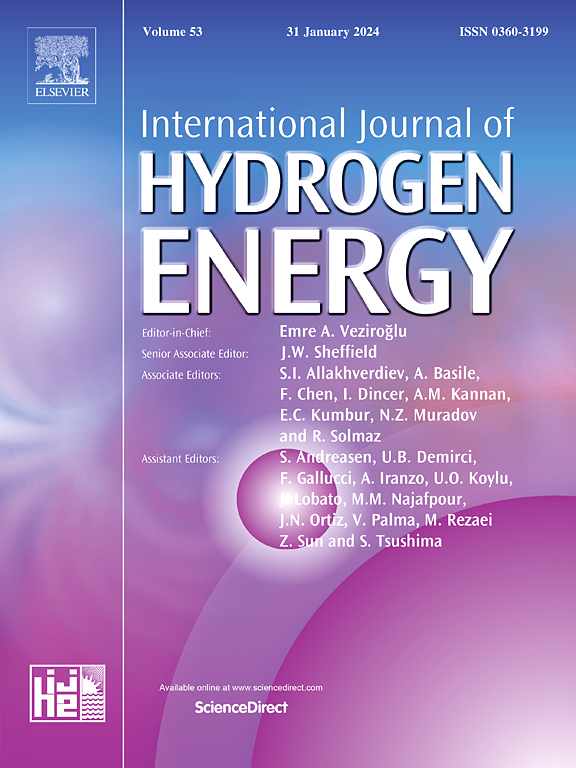用于可见光驱动光电化学水分离的二维还原氧化石墨烯诱导双功能质子 CuBi2O4/RGO/BiVO4/Au 异质结构
IF 8.1
2区 工程技术
Q1 CHEMISTRY, PHYSICAL
引用次数: 0
摘要
本研究探索了具有互补属性的不同光活性材料 CuBi2O4/RGO/BiVO4/Au 的双功能异质结构,用于可见光驱动的光电化学水分离。在所制造的双功能光电极 CuBi2O4/RGO/BiVO4/Au 中,材料的依次分层交换在改变光电极从光阳极到光阴极的动态过程中发挥了关键作用。在所有设计的光电极中,CuBi2O4/RGO/BiVO4/Au 在 0.69VAg/AgCl 的起始电位下显示出最高的电流密度(带紫外线截止滤光片(400 纳米)),为 0.15 mA/cm-2,最大值接近 0.25 mA/cm2,而不带紫外线截止滤光片时为 0.50 mA/cm2,这证明在能量较低的主要太阳光中,氧气和氢气的进化达到了 50%。在 BiVO4 中加入还原氧化石墨烯(RGO)和 CuBi2O4 可在可见光驱动的氧气(OER)和氢气进化(HER)反应中提高催化输出和快速光生电荷迁移属性。相比之下,在该异质结中引入金纳米粒子,通过热离子发射和隧道效应放大了光生电子的生成,从而提高了整体水分离效率。异质结 CuBi2O4/RGO/BiVO4/Au 将光生电子-空穴对的重组率降至最低,从而通过拓宽可见光吸收范围来帮助电荷分离。在恒定电位下,计时器测量结果表明电流随时间稳定流动,因此有助于有效利用双功能 CuBi2O4/RGO/BiVO4/Au 光电极来快速进行太阳能驱动的水分离,其 PEF 为 9.1%,ABPE 为 0.036%,IPCE 为 25%,IQE 为 20%。本文章由计算机程序翻译,如有差异,请以英文原文为准。
2D-reduced graphene oxide induced bi-functional plasmonic CuBi2O4/RGO/BiVO4/Au heterostructure for visible light driven photoelectrochemical water splitting
This study presents an exploration of bifunctional heterostructures of different photoactive materials with complementary attributes CuBi2O4/RGO/BiVO4/Au for visible-light-driven photoelectrochemical water splitting. The materials swapping in sequential layering within the fabricated bifunctional photoelectrode CuBi2O4/RGO/BiVO4/Au manifested a pivotal character in altering the dynamics of the photoelectrode from photoanode to photocathode. Among all designed photoelectrodes, CuBi2O4/RGO/BiVO4/Au exhibited the highest current density (with UV cutoff filter (400 nm)) of 0.15 mA/cm−2 at onset potential of 0.69VAg/AgCl with the maximum approach up to 0.25 mA/cm2, and without UV cut-off filter - 0.50 mA/cm2, verifying 50% evolution of oxygen and hydrogen within the less energetic and major portion of solar light. The incorporation of reduced graphene oxide (RGO) and CuBi2O4 with BiVO4 resulted in enhanced catalytic output and rapid photogenerated charge mobility attributes during the visible-light-driven oxygen (OER) and hydrogen evolution (HER) reactions. In contrast, the introduction of Au nanoparticles to this heterojunction magnified the photogenerated electron generation by thermionic emission and tunneling, resulting in high efficiency of overall water splitting. The heterojunction CuBi2O4/RGO/BiVO4/Au minimized the recombination rate of photogenerated electron-hole pairs and thus assisted charge separation by broadening the visible light absorption range. Under constant potential, the chronoamperometric measurements indicated the stable current flow over time and thus it facilitated the effective utilization of bifunctional CuBi2O4/RGO/BiVO4/Au photoelectrode for sleek and expeditious solar-driven water splitting with 9.1 PEF%,0.036 ABPE%, 25 IPCE%, and 20 IQE%.
求助全文
通过发布文献求助,成功后即可免费获取论文全文。
去求助
来源期刊

International Journal of Hydrogen Energy
工程技术-环境科学
CiteScore
13.50
自引率
25.00%
发文量
3502
审稿时长
60 days
期刊介绍:
The objective of the International Journal of Hydrogen Energy is to facilitate the exchange of new ideas, technological advancements, and research findings in the field of Hydrogen Energy among scientists and engineers worldwide. This journal showcases original research, both analytical and experimental, covering various aspects of Hydrogen Energy. These include production, storage, transmission, utilization, enabling technologies, environmental impact, economic considerations, and global perspectives on hydrogen and its carriers such as NH3, CH4, alcohols, etc.
The utilization aspect encompasses various methods such as thermochemical (combustion), photochemical, electrochemical (fuel cells), and nuclear conversion of hydrogen, hydrogen isotopes, and hydrogen carriers into thermal, mechanical, and electrical energies. The applications of these energies can be found in transportation (including aerospace), industrial, commercial, and residential sectors.
 求助内容:
求助内容: 应助结果提醒方式:
应助结果提醒方式:


